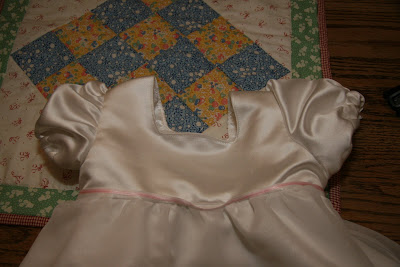In this tight economy who doesn't want to get the most bang for their buck? Here I'll outline how I'll use one simple pattern to create a couple more designs with more pizazz.
For those who want to follow along as I make my niece's birthday outfits this is where I'll start. As I mentioned in the previous post:
my niece K is quite small for her age. I recently made a corduroy jumper for her that fit great, so I've decided to start with that pattern for her tops.

Above is a photo of the fashion drawing and the corresponding pattern pieces I'll be using. There are actually additional pieces for the contrasting yoke and pocket pictured but I won't be using those.
Because this pattern uses such simple pieces I like to use it as an opportunity to manipulate the pattern a little to get some more interesting designs from it. I'll start with shortening the pattern by a few inches for a top because K let me know that she does
not like to wear dresses.
I wish I'd known that before I made the jumper.So, with a little drawing on my small scale pattern pieces I came up with two different new designs. There are so many adorable fabrics out there for children that I want to use several of them in these outfits. Here are rough drawings of my new designs for this pattern:

The pink lines indicate where I'll cut the pattern apart to make new pattern pieces. The upper pattern will produce a top with a panel effect allowing me to use two different fabrics. I'll be sure to end my princess line at the same point on the front and back shoulder so they match up. Because I don't have to worry about bust shaping for a princess line pattern for a toddler I can just add seam allowances on all the edges except the center front where I'll cut on the fold. I wouldn't recommend this kind of slicing of the pattern for a grown woman. Once you cut through the bust area there are a whole set of issues you must address to fit the rounded bust area. Below is a photo of my new pattern pieces for the first design. I have relabeled them with the familiar Lutterloh symbols to distinguish them from the original pattern.

A = front, AC = side front, B = back, BC = side back
The second design will allow me to make a top with a yoke and contrasting gathered skirt. On the full size pattern I'll need to start the yoke line at the same point on the armscye and then measure up from the bottom edge on both the front and back pieces for the end point. I'll then start with the same number on my curved ruler to draw the yoke line so the curve will be close to the same, front and back. I'll need to slice my pattern up some more to get enough fabric to gather onto the yoke. Here's what it will look like cut into pieces.

To get the fullness I need to achieve a gathered skirt I've split the pattern in three places all parallel to the center grainline. On each pattern piece I make sure to start the first and last split at least an inch away from center front or back and again an inch away from the point at the armscye. I just make the center split at a halfway point between those two.
I want to spread the pattern so I end up with nearly double the fullness of the original. I measure the length of the curved seam from the center front or back to the point at the armscye to determine how much to spread between each split. Let's say the top of the pattern piece measures 5 inches. To double the fullness I'll need to add 1-3/4 inches between each split to increase the width to about 10 inches. Once I fill in the spaces with paper I need to draw a new cutting line to smooth out the curve at the top. In the photo above I've marked this in pencil.
Below is a photo of what the pattern pieces will look like all filled in and relabeled with the Lutterloh symbols. Notice I included the wavy line at the top of the skirt pieces to tell me to gather there. Stopping the gathering before the armscye will make it easier to finish the armhole with binding.

A = front, AL = front yoke, B = back, BL = back yoke
Now, before I do any slicing and dicing of my original pattern I will draw a new copy to keep as a master pattern. This way I can start with this same shape over again by drawing new copies for each new design. I'll also draw copies of the facing pieces I've worked out for this master pattern. Once I sew the princess line pieces back together I should have the same shape as the master pattern so I'll use the same facing pattern pieces. For the yoked top I'll just cut two each of the front and back yokes and use those for facings.
Alrighty then, this is the general outline for starting K's tops. I'll get to the pants later but I'm anxious to get sewing.






















